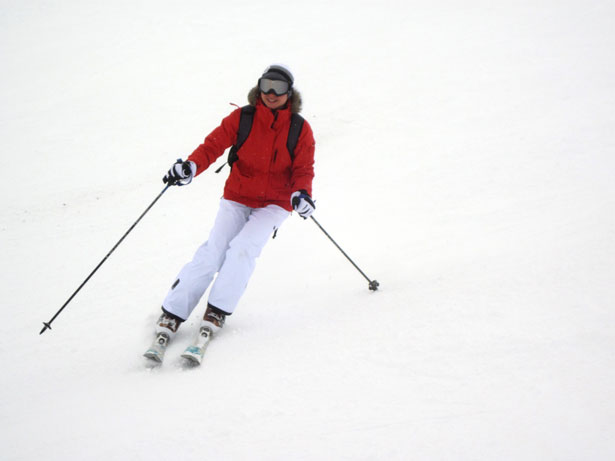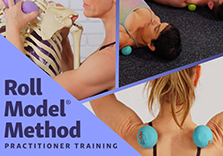
If you think about your legs—actually don’t think about them, look at them. Your legs are three-dimensional. Cylindrical in shape, with feet at the bottom and a pelvis at the top. Seems utterly elementary, no? Well, maybe not. As I sit at my computer typing what will be a brilliant anatomical blog (I hope!), I am seated with my hips and knees in flexion: the same action you do when you sit at your computer, or when you drive, or ride a bike, or run, or when you walk. In these movements, you utilize multiple directions of movement but only one plane of movement. The sagittal plane: the back and forth plane as it were.

Now, think about a speed skater or a roller blader or a cross-country skier. When they move they go forward but they also shift from left to right, into a second plane (called the frontal or coronal plane). That action also incorporates two more directions of movement: ADduction and ABduction. ADduction is when you draw your legs towards each other, ABduction is when you move them away from each other. The simplest illustration is jumping jacks. When you jump apart you ABduct. When you jump your legs together, you ADduct. The two antagonistic muscle groups that control these motions, are conveniently called ADductors and ABductors. Quick definition: An antagonist is a muscle that performs the opposite function of another muscle, called the agonist. They usually come in pairs.
Back to the first plane: forwards and backwards, flexion and extension. We sit, we stand, we bend over, we drive, we run, we bike, we walk. Those activities are all flexion-extension-flexion-extension. We know that repetitive muscle action creates habits of adaptive shortening in our muscle tissues. But what about muscles we use minimally because of daily life, like the abductors and adductors? When was the last time you started randomly fake speed skating or square dancing spontaneously? I’m guessing never. Mostly likely the only time you focus attention on these muscle groups is when you are at the gym doing lateral lunges, using the weight machines or in a yoga class practicing Prasarita Padottanasana and realizing how tight they are. Sidebar: Best gym reference ever…years ago, a friend at the gym referred to the AD/ABduction machines as the “Yes” and “No” muscle machines. Use your imagination. Moving on.
Both these often ignored muscle groups are immensely important to pelvic/hip stability.
The major hip abductors are: All three Gluteus siblings, Maximus, Medius and Minimus; the Tensor Fasciae Latae (TFL); and the Sartorius. These muscles not only move the leg laterally away from the centerline, but are totally key for hip stability. If they are weak, the pelvis will not remain horizontal when balancing on one foot or when walking. An imbalance on one side can create compensatory action on the opposite side, establishing poor postural habits or lower back pain. Weakness in these muscles can also allow for the knees to buckle towards the midline, throwing off alignment of the leg from hip to ankle.
The adductor group is made of 6 muscles: Adductor(s) magnus, longus and brevis; Pectineus; Gracilis; and drum roll please…Gluteus Maximus’ lower fibers doing double duty by partaking in adduction as well as abduction. The adductors stabilize the leg at the hip socket, keeping the leg aligned with the hip when walking, running or weight bearing. Again, weakness in this muscle group can create postural issues including bowing of the leg outward, possibly creating adaptive shortening in the abductors, which can lead to pain in the outer hip.
YTU has specific and effective movements to strengthen and stretch these connected muscles groups. In related articles I mention Prasarita Lunges and Adductor Slides; I would also recommend Abductor Lifts. Yoga Tune Up® has two versions of this exercise, one static and one dynamic. The dynamic version helps get synovial fluid into the hip socket while strengthening the muscles with slow, controlled motion. The static version is an isometric hold in which you work against gravity to fortify the outer hip. Strong hips, strong legs, strong posture. A more balanced you, top to bottom, left to right!











This article was very helpful in understanding why we focus so much on the inner thighs and hips during a lot of these poses .
Love the adductor and abductor exercises. So true that many yoga practices, are primarily comprised of sagittal plane movement. Important to include coronal and transverse plane movements to stabilize.
Thank you for this article. It is a good reminder to activate and strengthen the adductor and abductor muscles to balance the activity of hip flexion and extension.
This blog was so interesting to me! As a long time sufferer of chronic knee pain and finally being “diagnosed” with chondromalacia,I actually think that I may have more of a muscular issue happening in my lateral leg connection. I’m really looking forward into diving deep into lateral leg movement to see if I can help correct my knee alignment and increase my mobility. Thank you for another idea to pursue other than surgery or cortisone – I’m much more interested in the root cause than masking the problem!
Good reminder for the importance of preparing the body properly for all kind of sports (for my teenage multisports athletes that havent made their final choice of sport) to prevent injury by having healty hips
I appreciate your informative, detailed post with regard to ABduction and ADduction and the importance of using our bodies in difference plane of motion in order to keep the body balanced and strong. I realized as I was reading how, if you pay attention while doing exercises that use ABduction and ADduction, it can be diagnostic about imbalances in the pelvic / hip muscles (something I got myself into a few years back and have to be very conscious of preventing.)
Great article to point out the importance of all round works outs, with so much emphasis on walking running and spinning we forget about side to side. The more I study anatomy and movement the more I see weak areas in peoples bodies this is a common one. Got to get those ABductors and ADductors working.
Bringing awareness to these important muscles is so important! It’s not something I had thought of before diving into the level 1 training. The way this is explained here though makes it easy to relate to and remember the relationship between these muscles
The discussion regarding ABduction and ADduction has been routine and consistent in Level 1 training. I liked how the article discussed both the outside and inside muscles that provide hip and pelvic stability. You don’t realize what is happening until your body starts whispering. Ignoring is not an option because the whispers become shouts that can no longer be ignored. I found the pattern with older women that can be confusing to them as there are difficulties peeling down to the root cause, especially if they are postmenopausal.
I had a past Abductor tear and it is so scarey to let it do its job, and so necessary to get in a try. I need to get in and work the slides, lunges and Abductor lifts in order to bring movement back into this area of my body.
I have a family member who has a problem with in-toeing primarily on one side of the body. It was recently determined that this is a cause of tightness in the adductors, the hip is being pulled into internal rotation. While we have done techniques to lengthen this muscle group I did not think of strengthening the muscles that make up the abductors to create more stability at the pelvis and hip. Thank you for your insight.
I had no idea hip adductors and internal rotation are my blind spots until the training with Jill. I started noticing this weakness present everywhere from my yoga practice to skiing. And skiing with parallel turn does emphasize with leg has weaker adductors. My left inner thigh is pretty much a freeloader. Sadness! Will need to incorporate more hip adductors into my home practice and even my teaching.
Thanks Caitlin! Wish I could take credit for the Yes/No machine. It was pretty hilarious. And thank you everyone for your insightful and kind comments. Heidi
I didn’t think of that: that the legs would bow outward in the adductors were weak. Thank you for the context!
This is a great succinct explanation of the abducters and adducters and how they relate to different planes of movement. I talk to my students all the time about repetitive motion, but it’s to me to recognize that that’s all the same plan of movement and that the inner thighs and outer hips take us out of that plane. I also love the “Yes/No” Machine reference. I’ll remember that one!
Hey there how are you? Ever thought about why Trinity is not in the Bible, yet the churches expect you to accept that over echad of deuteronomy 6:4, the pluralism for ONE God? Man shall not live by bread alone but by every word of God Yahuwah, rather then a Paleo diet or Paleo Hebrew text will help find LIFE. Click HERE!
This has been one of my favourite articles to read- I am just learning my anatomy, so it is nice to be reminded which muscles are involved in which actions. Also, a good reminder I’ve recently heard about agonists is that the agonist is the muscle in “agony”. It has helped me learn which muscle is perform the major “force” of the movement.
After reading in one of Jill’s articles about the underuse / over stretching of the inner thighs of so many yoginis I started paying closer attention in class when I teach Vinyasa yoga and can attest the same. I now incorporate Prasarita Lunges in almost every class, and in addition to being a great strengthened for inner & outer hips and things, it can also be a great warming pose and is playful and fun.
This piece reminded me how important the hip adductors are to even just
standing, extending and flexing.
I remember back to a time when, as you say, they were just invisible to me. I
never gave them a moment’s thought.
Then one day, as part of a new exercise program I had undertaken, I lay on my
back with my legs against the wall. Allowing my legs to open as much as they
wanted for a few minutes I definitely became aware of how much I had neglected
my inner thighs. Then, standing up and walking after that my mind was blown as to
how much better my back felt and how much more fluid my gait was. Since then
the term “hip stabilizers” has a 3-D meaning for me.
This article really got me thinking about the importance of the abductors and adductors for pelvic stability. Throughout the journey of my yoga practice, I have found that one challenge I come up against often is improper alignment of my pelvis and hips. In many poses, I hear my teachers asking for both hips to be facing the same way or in the same line. Many times, I will look down and what do you know? One hips is higher than the other or one hip has been left behind. After reading this blog post, I am realizing that I should be looking to these potentially underused abductor and adductor muscle groups to regain control of the pelvis.